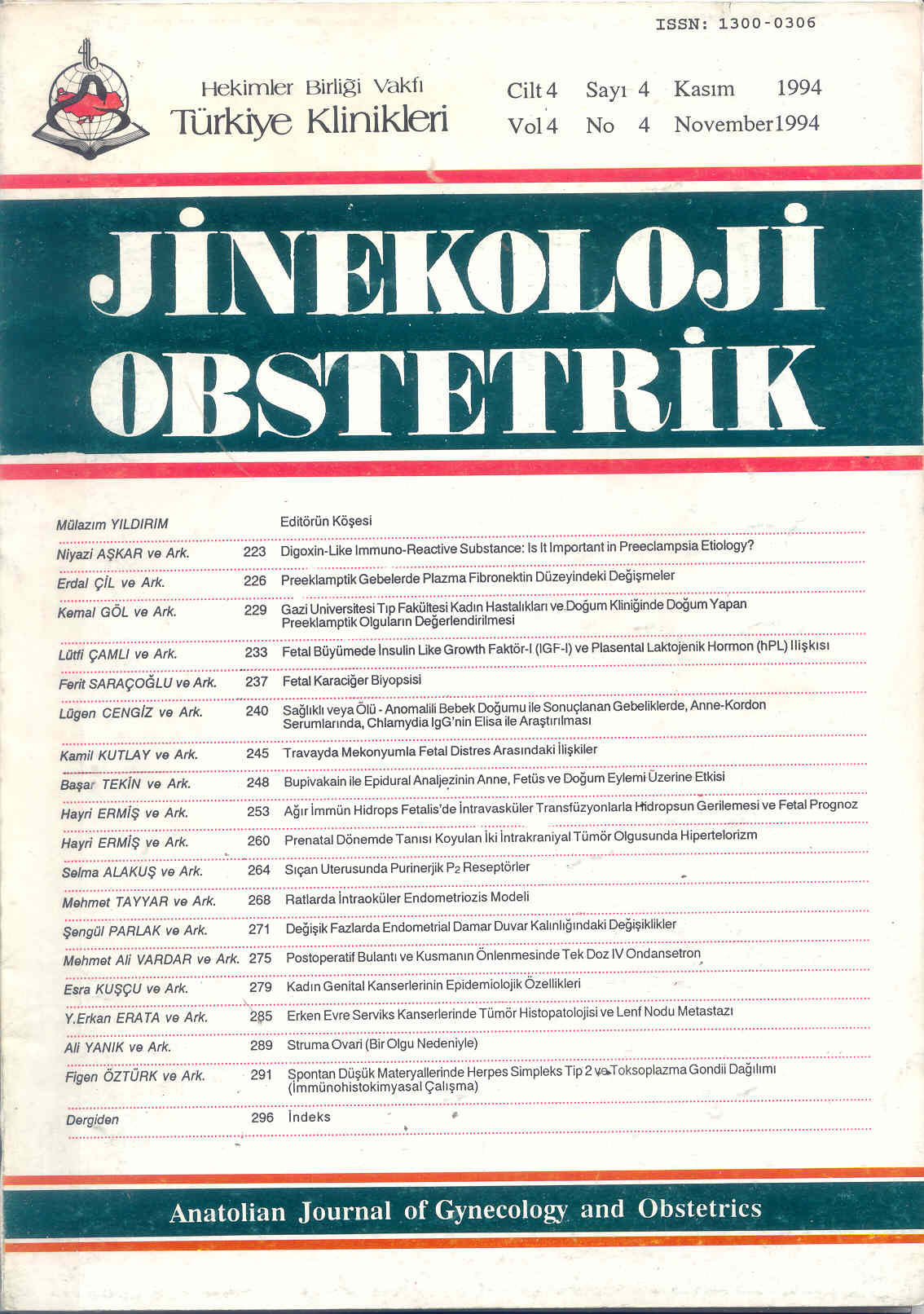Open Access
Peer Reviewed
ARTICLES
3020 Viewed1007 Downloaded
Digoxin-Like Immuno-Reactive Substance: Is It Important in Preeclampsia Etiology?
Digoksin-Benzeri İmmün-Reaktif Madde: Preeklampsi Etyolojisinde Önemli Mi?
Turkiye Klinikleri J Gynecol Obst. 1994;4(4):223-5
Article Language: TR
Copyright Ⓒ 2025 by Türkiye Klinikleri. This is an open access article under the CC BY-NC-ND license (http://creativecommons.org/licenses/by-nc-nd/4.0/)
ÖZET
Amaç: Preeklamptik ve normal gebelerde Digoksin benzeri immün-reaktif maddenin (DBİM) serum ve amniotik sıvı konsantrasyonlarını saptamak ve DBİM'in preeklampsi etyolojisinde rolü olup olmadığını araştırmak. Çalışmanın Yapıldığı Yer: Ege Üniversitesi Tıp Fakültesi Kadın Hastalıkları ve Doğum AD ve Farmakoloji AD, İzmir. Materyel ve Metod: 15 preeklamptik ve 15 normal gebede serum ve amniotik sıvı Digoksin konsantrasyonları ölçüldü. İstatistiksel değerlendirme student t testi ile yapıldı. Bulgular: Ortalama serum ve amniotik sıvı DBİM konsantrasyonları preeklamptik hastalarda 0.15 ± 0.01 ve 0.59 ± 0.09 ng/ml, normal gebelerde ise 0.12 ± 0.01 ve 0.57 ± 0.09 ng/ml olarak bulundu (İstatistiksel olarak anlamsız, p> 0.05). Sonuç: DBİM preeklamptik hastalarda gebeliğin 3. trimesterinde yükselmediği için, bu testin preeklamptik gebelerin önceden belirlenmesinde bir test olarak kullanılamayacağı ve preeklampsi etyolojisinde önemli bir rolünün olmadığı kanısına varıldı.
Amaç: Preeklamptik ve normal gebelerde Digoksin benzeri immün-reaktif maddenin (DBİM) serum ve amniotik sıvı konsantrasyonlarını saptamak ve DBİM'in preeklampsi etyolojisinde rolü olup olmadığını araştırmak. Çalışmanın Yapıldığı Yer: Ege Üniversitesi Tıp Fakültesi Kadın Hastalıkları ve Doğum AD ve Farmakoloji AD, İzmir. Materyel ve Metod: 15 preeklamptik ve 15 normal gebede serum ve amniotik sıvı Digoksin konsantrasyonları ölçüldü. İstatistiksel değerlendirme student t testi ile yapıldı. Bulgular: Ortalama serum ve amniotik sıvı DBİM konsantrasyonları preeklamptik hastalarda 0.15 ± 0.01 ve 0.59 ± 0.09 ng/ml, normal gebelerde ise 0.12 ± 0.01 ve 0.57 ± 0.09 ng/ml olarak bulundu (İstatistiksel olarak anlamsız, p> 0.05). Sonuç: DBİM preeklamptik hastalarda gebeliğin 3. trimesterinde yükselmediği için, bu testin preeklamptik gebelerin önceden belirlenmesinde bir test olarak kullanılamayacağı ve preeklampsi etyolojisinde önemli bir rolünün olmadığı kanısına varıldı.
ANAHTAR KELİMELER: Digoksin-benzeri, immün-reaktif madde, preeklampsi, gebeliğin hipertansif hastalıkları
ABSTRACT
Objective: To determine and amniotic fluid Digoxin-like immuno-reactive substance (DLIS) concentrations of preeclamptic pregnant women and to investigate whether DLIS has an etiologic role in preeclampsia. Institution: Ege University Medical Faculty, Department of Obstetrics and Gynecology and Department of Pharmacology, İzmir. Material and Methods: 15 preeclamptic and 15 non-preeclamptic pregnant women were investigated serum and amniotic fluid Digoxin concentrations were measured. The statistical analysis was evaluated by student's t test. Findings: The mean serum and the amniotic fluid digoxin concentrations were measured as 0.15 ± 0.01 and 0.59 ± 0.19 ng/ml in preeclamtic patients and 0.12 ± 1.01 and 0.57 ± 0.09 ng/ml in non-preeclamtic patients, statistically non-significant (p> 0.05). Results: Digoxin-like immuno-reactive substance concentrations are not elevated in preeclampsia in the third trimester, it is very unlikely that this test will be helpful in predicting preeclampsia and may play a major role in the development of preeclampsia.
Objective: To determine and amniotic fluid Digoxin-like immuno-reactive substance (DLIS) concentrations of preeclamptic pregnant women and to investigate whether DLIS has an etiologic role in preeclampsia. Institution: Ege University Medical Faculty, Department of Obstetrics and Gynecology and Department of Pharmacology, İzmir. Material and Methods: 15 preeclamptic and 15 non-preeclamptic pregnant women were investigated serum and amniotic fluid Digoxin concentrations were measured. The statistical analysis was evaluated by student's t test. Findings: The mean serum and the amniotic fluid digoxin concentrations were measured as 0.15 ± 0.01 and 0.59 ± 0.19 ng/ml in preeclamtic patients and 0.12 ± 1.01 and 0.57 ± 0.09 ng/ml in non-preeclamtic patients, statistically non-significant (p> 0.05). Results: Digoxin-like immuno-reactive substance concentrations are not elevated in preeclampsia in the third trimester, it is very unlikely that this test will be helpful in predicting preeclampsia and may play a major role in the development of preeclampsia.
MENU
POPULAR ARTICLES
MOST DOWNLOADED ARTICLES





This journal is licensed under a Creative Commons Attribution-NonCommercial-NoDerivatives 4.0 International License.










